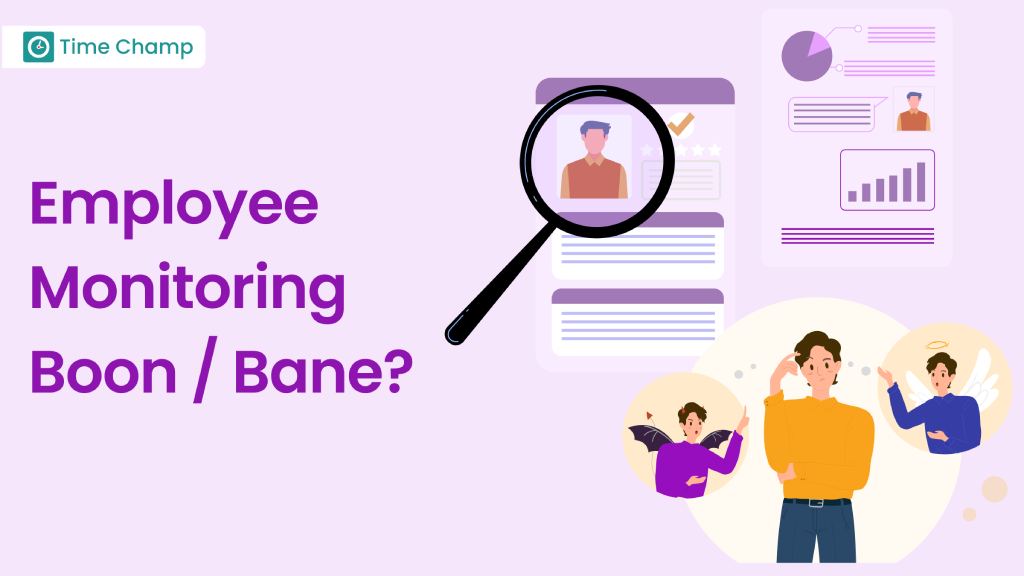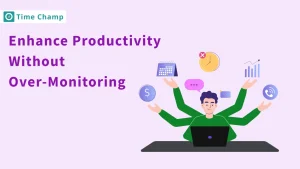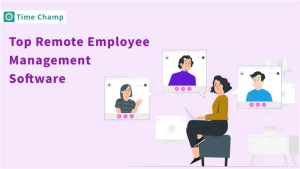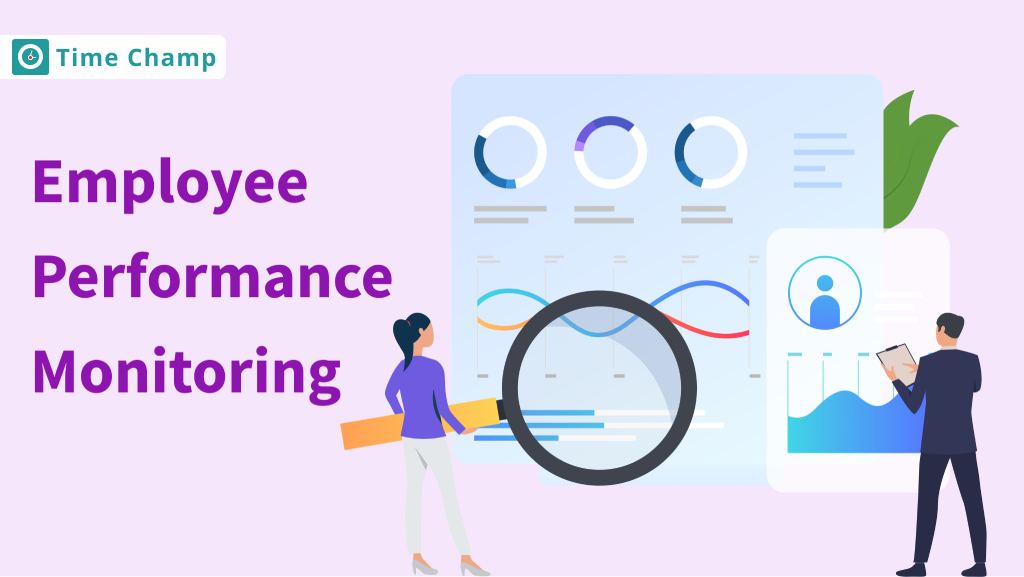Employee monitoring is currently a hot topic in modern workplaces. Some view it as a game changer that enhances employee productivity. Others think it will destroy employee privacy and make the working environment tense. This blog takes a deep dive into both sides of this debate about whether employee monitoring is an actual boon or bane. Get ready to discuss whether employee monitoring is a useful tool that helps optimize your work environment and maximize the productivity of employees.
What is Employee Monitoring?
Employee monitoring is the process of
observing the employee activity at
the workplace through their computer
usage. It tracks
applications used, the URLs
visited, the keystrokes typed, the
screens viewed and more. With the
help of this organizations can
assess the employees’
productivity.
Did you know why
employee monitoring has increased
recently?
Technological Change and Its Impact on Employee Monitoring
Technological advancements are
changing the workplace dynamics and
how employees engage with their work
environment. This change is
especially due to the increase in
virtual and remote
work arrangements. It is
caused by globalization and the
COVID-19 pandemic. With the growth
of remote employees, it becomes
essential to manage employees to
enhance
performance. In this
regard, employee
monitoring tools have become
the solution.
Employee Monitoring Boon or Bane for Organizations?
Let’s discuss whether employee monitoring has become a boon or bane for modern workplaces. Employee monitoring is a boon or bane depending on how an organization uses it.
What Makes an Employee Monitoring Boon
Using employee monitoring software can give the following benefits which make it a boon.
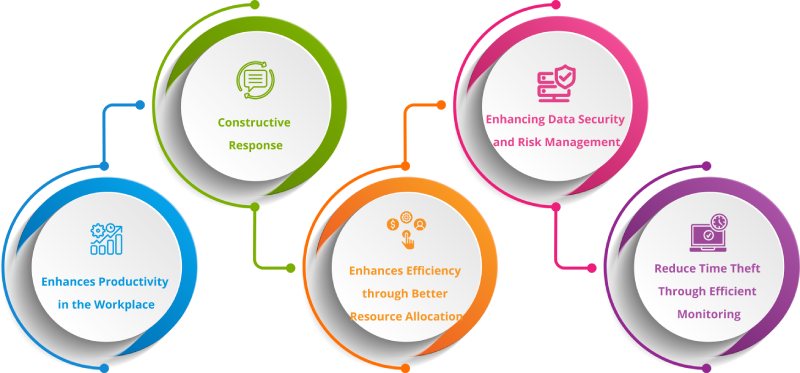
1. Enhances Productivity in the Workplace
Employee monitoring increases productivity because it tracks how employees utilize their time and points out where they can improve. Now, Employees tend to be dedicated because they know their activities are being monitored. It reduces the chances of distraction, and it improves performance. Ultimately it helps to increase employee productivity in the workplace.
2. Makes Employees More Committed to their Work Through Constructive Response
Monitoring software can give input on employee performance which can help you provide accurate and constructive feedback. This feedback establishes a culture of accountability and growth. So, encouraging employees with a fair reward system makes the workplace more efficient.
3. Enhances Efficiency through Better Resource Allocation
Monitoring real-time data helps in
the proper planning of resources.
Monitoring data helps managers to
know what employees are doing at any
time and assign duties to the most
suitable. Workload
distribution insights
ensure tasks are evenly
distributed, preventing
employees from being
overstrained. It provides
teams with the right ingredients for
project success and overall
effectiveness.
4. Enhancing Data Security and Risk Management
When you monitor you can eliminate insider threats because the employees are under surveillance. Handling the risks is easy because you can monitor every employee’s activity. This improves data security and manages the risks.
5. Reduce Time Theft through Efficient Monitoring
Effective monitoring minimizes time theft. By tracking login time, task duration, idle periods and inactivity periods. It makes employees work during official hours. As a result, productivity and accountability increased, since they will be focused on their jobs ensuring timely completion of tasks.
When Employee Monitoring Becomes Bane for the Modern Workplace?
Sometimes employee monitoring can also become the bane for modern workplaces under some circumstances. Here are some reasons why employee monitoring can be a major issue for modern workplaces, if not handled with caution:
- If employee privacy is not protected by an organization, extensive monitoring may pose a serious threat to employees’ privacy. This may feel like intrusiveness into every aspect of their work or sometimes personal life. The violation of this privacy may cause discomfort and undermine trust between employees and their management.
- If monitoring leads to micromanagement, it could create a suffocating environment where workers think that they are being followed in everything they do. The constant surveillance can result in irritation and lack of self-determination leading to decreased spirit and employee satisfaction on the job.
- If the organization overlooks legal standards in its monitoring practices, such practices might cross the line. This may lead to breaking monitoring laws and regulations and expose such organizations to potential troubles with litigation, fines, and spoiling their reputation.
- If organizations do not prioritize data security, monitoring data remains unprotected. Which creates a risk to employees’ personal information
Also Read: Pros and Cons of Employee Monitoring
Best Practices for Implementing Employee Monitoring
Let’s discuss the best practices that make employee monitoring a boon for the workplace.
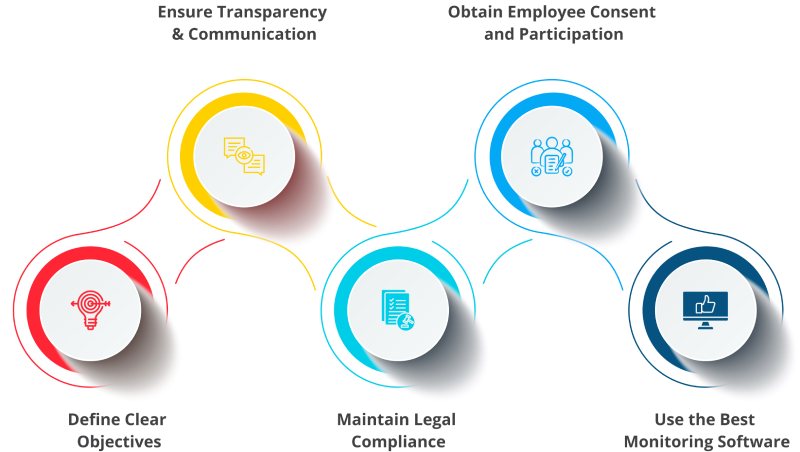
1. Define Clear Objectives
Be explicit about why you want to monitor employees and what you expect from it. Set definite objectives for employee monitoring in the workplace. For example, if you want to raise efficiency, say you aim to spot time-wasting tasks and make work processes smoother. If you want to improve safety, say you plan to check if everyone follows safety rules and reduce the chances of accidents. It helps employees understand the purpose of monitoring and prevents any misunderstandings.
2. Ensure Transparency and Communication
It is important to be transparent
about the monitoring of employees.
Make sure that your employees know
what will be monitored, how it will
be done, and why it is being done.
Effective communication helps to
establish trust and
decrease
the negative perception of privacy
violations. Thus, employees will be
more willing to work together and
contribute to the success of an
organization. Therefore, it is
always best to be honest and
transparent about the monitoring
that you are doing.
3. Maintain Legal Compliance
Ensure that all your monitoring activities comply with the laws applicable in your jurisdiction. Have knowledge about privacy legislation as well as worker rights in your locality. Abiding by the law will help your company avoid being entangled in legal problems and demonstrate to your staff that they are respected. Therefore, always ensure that your monitoring practices comply with the law!
4. Obtain Employee Consent and Participation
It is important to get the employee’s consent when monitoring. Explain how the monitoring will be done and consider any employee concerns that arise. This approach is quite considerate of their privacy and is a way of gaining their confidence. When employees are informed and engaged in the workplace, they are more likely to be supportive. Therefore, always obtain their permission and ensure employees are willing to participate in monitoring.
5. Implement Data Security Measures
Data security should not be compromised when using monitoring tools in the workplace. Ensure that all collected data is protected from unauthorized access or hacking by encrypting the data and using strong passwords. It is important to store the data securely and update the security protocols often. This safeguards your company and demonstrates to employees that their privacy is valued. Additionally, always follow data protection laws to ensure legal compliance and maintain trust.
6. Regularly Review and Adjust Policies
Organizations need to adapt to the changing technology trends and workplace needs. So, continuously review and adjust the employee monitoring policies. It helps in ensuring that the practices remain effective, and fair while adapting to any changes within the work environment.
7. Use the Best Monitoring Software
Monitoring software plays a crucial role in monitoring employees’ data. So, choose a monitoring software that is efficient and reliable. Time Champ can be your best choice as a monitoring software. It has comprehensive features like time tracking, activity tracking, automatic attendance, screen monitoring, location tracking and more. These features help for effective monitoring of employees in the workplace. The best thing about the Time Champ is that it gives instant reports and a user-friendly interface.
Conclusion
Employee monitoring is an essential tool in modern workplaces due to technological changes. Employee monitoring is a boon or bane for an organization depending on how it is used. If the organization ensure employee privacy, data security and legal requirements then monitoring becomes a boon. It helps to increase productivity, better resource allocation and decreases time theft. Otherwise, it becomes a bane and causes several problems. If you want to make it a boon you need to follow the best practices like clear policies, maintaining legal compliance and using the best monitoring software like Time Champ.
Wondering How to Make Employee Monitoring a Boon?
Transform your workplace with Time Champ's smarter monitoring solutions.
Signup for FreeBook a Demo
